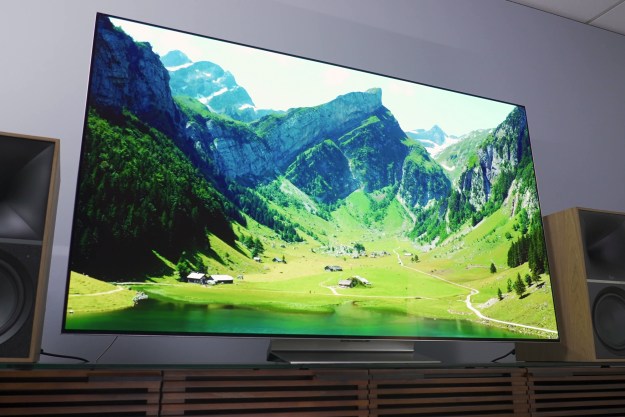Pioneer today unveiled details about three new Atmos-ready Elite SC-series A/V receivers and a selection of Andrew Jones-designed, Atmos-ready Elite speakers. Below, we’ve got all the details on the receivers and speakers, and how they will all connect together to deliver the newly-introduced Dolby Atmos experience for home theater. Also, be sure to check out our gallery, where you can see detailed photos of the receivers, their rear panels and the new Elite speakers.
Atmos and Multi-zone
Pioneer’s SC-85 ($1600), SC-87 ($2000), and SC-89 ($3000) will not decode and play back Dolby Atmos-encoded movies right out of the box, but a firmware update the company says will be available by the end of the year will add the functionality in retroactively. All three models sport 9.2 channels which Pioneer says can reconfigured 11 different ways (12 with SC-87 and SC-89). Configurations can be selected and implemented either through the receiver or through Pioneer’s free iControlAV5 App for iOS and Android devices. In addition to a true 9.2-channel speaker setup or any variation of Atmos surround configurations, each receiver can power a 5.1 speaker system in one room, with the extra outputs left to drive speakers in other rooms.
Power and processing
At the core of the receiver is Pioneer’s proprietary D3 amplfier, a digital amplifier design that Digital Trends has found offers the sort of natural, warm and accurate sound other digital amps struggle to achieve. At the source end, Pioneer employs SABRE32 Ultra DACs in all three models, with the SC-89 sporting a USB 32-Bit Asynchronous Audio DAC for direct connection to Mac and Windows computers. As such, the three receivers will play back nearly any sort of digital audio file, including high-resolution FLAC, ALAC and native DSD files.
Internet content delivered
Pioneer says all three receivers are Roku-ready certified. That means a Roku Streaming Stick can be plugged directly into an MHL port in the back of the receiver, and be controlled using either the receiver remote, or the iControlAV5 App. In addition to access to Netflix, Hulu Plus, Amazon Instant and thousands of other streaming apps through the Roku stick, Pioneer has built in support for Internet radio services such as Spotify, Pandora and vTuner.
4K for days
Pioneer says all of its new receivers feature HDMI 2.0 ports, which will allow up to 18Gbps of throughput, allowing for 4K at 60p, with 4:4:4 color support (the maximum Ultra HD allows).
Andrew Jones Atmos-enabled Elite speakers
The fact that Andrew Jones’ name is stamped on the this new speaker line is no matter of marketing fluff. Andrew Jones takes the task of delivering high-performance audio from affordable speaker systems seriously, and his first effort in partnership with the Pioneer brand, the Pioneer SP-PK52FS system, is by far the best speaker system we’ve heard under $600. With this new line, not only has Jones stepped up component quality and designed a more attractive speaker, but the come with the ability to deliver the Atmos experience by incorporating specialized drivers at the top of the speaker cabinets that fire at the ceiling, reflecting Atmos-specific sound information off the ceiling (as an alternative to ceiling-mounted speakers).
Speaker specs
The speaker system is comprised of the SP-EFS73 floorstanding speakers ($699 each), the SP-EBS73-LR bookshelf speakers ($749/pair), SP-EC73 center channel speaker ($399), and SW-E10 subwoofer ($599), with a total system cost of $3145.
As shown in the pictures above, none of the new speakers use an independently mounted tweeter. Instead, Andrew Jones designed what Pioneer is calling a CST, or Coherent Source Transducer. In a nutshell, the idea behind the technology was to develop a single point source so that the midrange and tweeter speakers had the same directional characteristcs. Also, by mounting a 1-inch soft dome tweeter over a 4-inch aluminum midrange cone coaxially, Pioneer was able to save some cabinet space, which likely came in handy when designing the Atmos-related elements of the speaker. In the floorstanding models, the CST is accompanied by three 5.25-inch drivers; in the bookshelf speakers by one 5.25-inch driver, and in the center channel by a one 5.25-inch driver and a 5.25-inch passive bass radiator.
As for the E10 subwoofer, Pioneer utilizes a BASH amplifier capable of delivering 600 watts peak (300 watts RMS), which is sculpted by DSP to achieve the sound Andrew Jones required.
To make these speakers Atmos-enabled, Pioneer added one of the CST drivers to the top of each floorstander and bookshelf speaker. Separate binding posts at the back of the speakers allows discreet information to be delivered to the Atmos-dedicated drivers, which are aimed at the ceiling to reflect Atmos-specific effects down at the listener from above.
The whole pacakage
At the time of this writing, Pioneer is the first and only manufacturer to offer a complete Dolby-Atmos solution from Blu-ray player right through to the speaker system, though we’re sure to see that change in the coming months. We’ll update this article when the official Atmos firmware upgrade availability date is announced.
Editors' Recommendations
- Pioneer’s latest budget-friendly Dolby Atmos AV receivers start at $379
- Apple HomePod can replace a Dolby Atmos soundbar when paired with Apple TV 4K
- Samsung’s 2020 soundbar lineup adds Dolby Atmos to your TV starting at $700
- The next-gen TiVo Edge DVR will provide 4K, Dolby Vision, and Dolby Atmos … eventually




